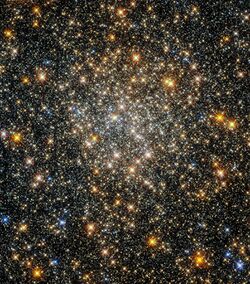Astronomy:Palomar 6
From HandWiki
| Palomar 6 | |
|---|---|
 | |
| Observation data (J2000 epoch) | |
| Class | XI |
| Constellation | Ophiuchus |
| Right ascension | 17h 43m 42.20s[1] |
| Declination | −26° 13′ 21.0″[1] |
| Distance | 25.02 ± 0.62 kly (7.67 ± 0.19 kpc)[2] |
| Physical characteristics | |
| Mass | 2.28×105[3] M☉ |
| Metallicity | = –0.91[3] dex |
| Estimated age | 12.4 ± 0.9 Gyr[2] |
| Other designations | ESO 520-21, GCl 75, 1740-262[1] |
Palomar 6 is a loose globular cluster in the constellation Ophiuchus that belongs to the Milky Way galaxy. It is a member of the Palomar Globular Clusters group. It is located about 25,000 light-years (7,700 parsecs) away from the Sun.[2] It formed in what would become the bulge of the Milky Way. It is similar to other old-bulge globular clusters such as Messier 62, NGC 6522, NGC 6558, and Haute-Provence 1.[2]
First discovered on the National Geographic Society – Palomar Observatory Sky Survey plates by Robert G. Harrington and Fritz Zwicky,[4] it was catalogued as a globular cluster, and is one of four globulars known to contain a planetary nebula.
References
- ↑ 1.0 1.1 1.2 "SIMBAD Astronomical Database". Results for Palomar 6. http://simbad.u-strasbg.fr/Simbad. Retrieved 2009-10-04.
- ↑ 2.0 2.1 2.2 2.3 Souza, S. O.; Valentini, M.; Barbuy, B.; Pérez-Villegas, A.; Chiappini, C.; Ortolani, S.; Nardiello, D.; Dias, B. et al. (2021). "Photo-chemo-dynamical analysis and the origin of the bulge globular cluster Palomar 6". Astronomy & Astrophysics 656: A78. doi:10.1051/0004-6361/202141768.
- ↑ 3.0 3.1 Boyles, J. et al. (November 2011), "Young Radio Pulsars in Galactic Globular Clusters", The Astrophysical Journal 742 (1): 51, doi:10.1088/0004-637X/742/1/51, Bibcode: 2011ApJ...742...51B.
- ↑ Abell, George O. (1955). "Globular Clusters and Planetary Nebulae Discovered on the National Geographic Society-Palomar Observatory Sky Survey". Publications of the Astronomical Society of the Pacific 67 (397): 258. doi:10.1086/126815. Bibcode: 1955PASP...67..258A.
External links
- Simbad reference data
- SEDS: Palomar 6, Capricornus Dwarf
- Palomar 6 on WikiSky: DSS2, SDSS, GALEX, IRAS, Hydrogen α, X-Ray, Astrophoto, Sky Map, Articles and images
- NASA Astronomy Picture of the Day: Palomar 6: Globular Star Cluster (19 October 2021)
Coordinates: ![]() 17h 43m 42.20s, −26° 13′ 21.0″
17h 43m 42.20s, −26° 13′ 21.0″
 |

